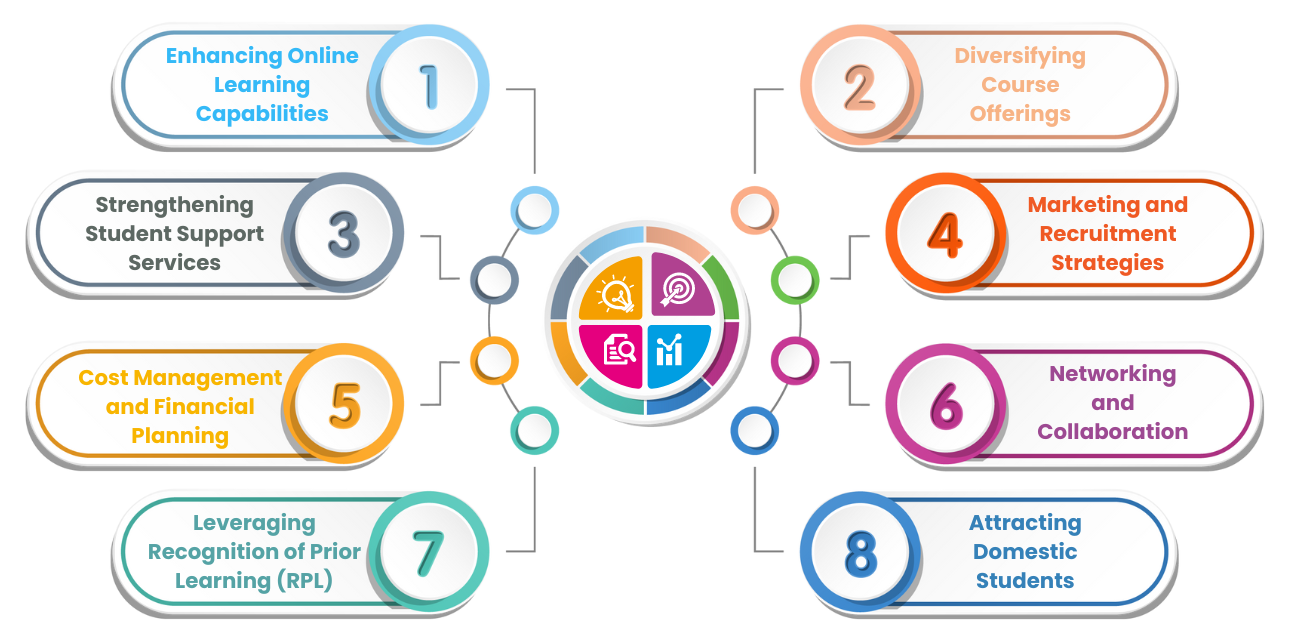In the ever-evolving landscape of international education, CRICOS Registered Training Organisations (RTOs) are currently facing a significant challenge: a notable decrease in student enrollment in Vocational Education and Training (VET) courses, expected to persist for the next 12 to 18 months. This period demands not just resilience but strategic innovation from RTOs to not only survive but thrive. This guide outlines actionable strategies for CRICOS RTOs to navigate these turbulent times effectively.
Understanding the Challenges
The decline in student enrollment can be attributed to several factors, including global economic uncertainties, stringent migration policies, and an increasingly competitive education sector. These challenges necessitate a reevaluation of traditional operational models and the adoption of more dynamic, student-centric approaches.
Strategies for Survival

1. Enhancing Online Learning Capabilities

The digital transformation of education is no longer optional. Investing in high-quality online learning platforms enables RTOs to offer flexible, accessible education, broadening their appeal to both international and domestic students.
2. Diversifying Course Offerings

Adapting course offerings to meet current market demands and future industry trends can attract a wider student base. Collaborating with industries to provide practical, job-oriented training can significantly enhance the value of VET courses.
3. Strengthening Student Support Services

Comprehensive support services, including counseling, language assistance, and job placement support, can improve student retention and success rates, making your RTO more attractive to prospective students.
4. Marketing and Recruitment Strategies

Developing targeted marketing campaigns and leveraging digital platforms can enhance your RTO’s visibility and appeal to a global audience. Virtual tours and webinars can effectively showcase your offerings to prospective students.
5. Cost Management and Financial Planning

In times of low enrollment, meticulous cost management and strategic financial planning become paramount for sustaining operations without compromising the quality of education. Here are some detailed strategies:
- Operational Efficiency: Audit your current expenses to identify areas where costs can be reduced without affecting educational delivery. This might include renegotiating contracts, reducing non-essential expenditures, and optimizing resource allocation.
- Revenue Diversification: Explore alternative revenue streams beyond tuition fees. This could involve offering short courses, professional development workshops for businesses, or renting out facilities.
- Government and Industry Support: Stay informed about government grants, subsidies, and support programs designed to aid educational institutions. Additionally, forming partnerships with industry can lead to sponsored programs or scholarships.
- Financial Forecasting: Develop detailed financial forecasts to anticipate cash flow challenges and plan accordingly. This should include scenario planning for various enrollment levels and external economic conditions.
6. Networking and Collaboration
Building partnerships with other educational institutions, industry bodies, and community organisations can open up new opportunities for collaboration, knowledge exchange, and student pathways.
7. Leveraging Recognition of Prior Learning (RPL)
RPL is a critical tool for acknowledging the skills and knowledge that students have acquired outside formal education. Here’s how to effectively leverage RPL:
- Clear RPL Policies and Procedures: Establish transparent and accessible RPL assessment processes. This includes providing detailed guidelines on how to apply, what evidence is required, and the assessment criteria.
- Marketing RPL Opportunities: Actively promote RPL as a pathway to attract students who might not have considered further education due to their extensive work experience or previous informal training.
- Support and Guidance for Applicants: Offer dedicated support for RPL applicants, including advisory services to help them understand the process and gather the necessary documentation.
- Quality Assurance: Ensure that RPL assessments maintain the integrity and standards of your qualifications. Regularly review and update RPL policies to reflect industry changes and educational standards.
8. Attracting Domestic Students
With international student numbers fluctuating, attracting domestic students can provide a more stable enrollment base. Here are strategies to increase domestic student engagement:

- Course Relevance: Align course offerings with the current job market and future industry trends. Conduct market research to understand the skills and qualifications in demand within the local economy.
- Flexible Learning Options: Offer flexible study options, including part-time, online, and evening classes, to appeal to working professionals and other non-traditional students.
- Community Engagement: Increase your presence in the local community through events, school partnerships, and public seminars. This not only raises awareness of your RTO but also positions you as a valuable community resource.
- Financial Incentives: Consider scholarships, bursaries, and flexible payment plans to make education more accessible to domestic students. Highlighting these options in your marketing can remove financial barriers to enrollment.
- Career Pathways: Develop clear pathways from your courses to employment by working closely with local industries. This could include internships, placement programs, and industry projects integrated into the curriculum.
Preparing for Recovery
While addressing immediate challenges, it’s also vital for RTOs to prepare for the future. This means continuously innovating, improving course quality, and staying adaptable to the evolving educational landscape. The strategies outlined here not only aim to navigate through current challenges but also to position RTOs for long-term success and growth.
Conclusion
The current challenges facing CRICOS RTOs are significant but not insurmountable. By embracing innovative strategies such as enhancing online learning, diversifying course offerings, strengthening student support, and focusing on both RPL and domestic students, RTOs can navigate these turbulent times. The key to success lies in adaptability, resilience, and a commitment to providing high-quality education that meets the needs of all students, whether they’re from across the street or across the globe.
Disclaimer:
The information presented on the VET Resources blog is for general guidance only. While we strive for accuracy, we cannot guarantee the completeness or timeliness of the information. VET Resources is not responsible for any errors or omissions, or for the results obtained from the use of this information. Always consult a professional for advice tailored to your circumstances.






